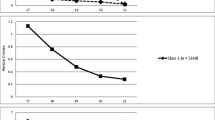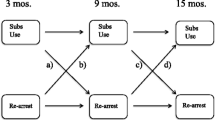Abstract
In the present study the relationship between chronicity and violent recidivism is analyzed using longitudinal data from the 1958 Philadelphia cohort. The data reaffirm prior research findings that a small cadre of offenders commits the majority of crimes which involve serious harm to the community, yet it was found that the violent offenders accounted for a large share of the more serious index offenses. In addition, among violent delinquents there is a greater proportion of chronic offenders than among nonviolent delinquents. Chronic offenders were more likely than nonchronic offenders to repeat a violent offense. Violent recidivists also committed a large proportion of nonviolent index offenses. One might imply from the results of this study that a policy of selective incapacitation of high-rate offenders would substantially reduce the amount of violent crime as well as nonviolent crime.
Similar content being viewed by others
References
Blumstein, A. (1983). Crime control: The search for predators. In Feinberg, K. R. (ed.),Violent Crime in America, National Policy Exchange, Washington, D.C., pp. 2–16.
Blumstein, A., and Moitra, S. (1980). The identification of career criminals from chronic offenders in a cohort.Law Policy Q. 2: 321–334.
Boland, B., and Wilson, J. Q. (1978). Age, crime and punishment.Public Interest 51: 22–34.
Chaiken, J., and Chaiken, M. R. (1982).Varieties of Criminal Behavior, Rand, Santa Monica, Calif.
Clarke, S. (1974). Getting 'em out of circulation: Does incapacitation of juvenile offenders reduce crime?J. Crim. Law Criminol 65(4): 528–535.
Cohen, J. (1978). The incapacitative effect of imprisonment: A critical review of the literature. In Blumstein, A., Cohen, J., and Nagin, D. (eds.),Deterrence and Incapacitation: Estimating the Effects of Criminal Sanctions on Crime Rates, National Academy of Sciences, Washington, D.C., pp. 187–243.
Curtis, L. (1974).Criminal Violence, Lexington Books, Lexington, Mass.
Fagan, J., Jones, S., Hartstone, E., Rudman, C., and Emerson, R. (1981). Background paper for the Violent Juvenile Offender Research and Development Program. URSA Institute, San Francisco.
Farrington, D. P. (1971). Self-reports of deviant behavior: Predictive and stable?J. Crim. Law Criminol. 11: 341–359.
Glueck, S., and Glueck, E. (1959).Predicting Delinquency and Crime, Harvard University Press, Cambridge, Mass.
Greenberg, D. (1975). The incapacitative effect of imprisonment: Some estimates.Law Soc. Rev. 9(4): 541–580.
Greenwood, P. (1982).Selective Incapacitation, Rand, Santa Monica, Calif.
Guttridge, P., Gabrielli, W. F., Jr., Mednick, S., and van Dusen, K. T. (1983). Criminal violence in a birth cohort. In van Dusen, K. T., and Mednick, S. (eds.),Prospective Studies of Crime and Delinquency, Kluwer-Nijhoff, Boston, pp. 211–224.
Haapanen, R. A., and Jesness, C. F. (1982).Early Identification of the Chronic Offender, Department of Youth Authority, State of California, Sacramento.
Hamparian, D. M., Schuster, R., Dinitz, S., and Conrad, J. P. (1978).Tne Violent Few, D. C. Heath, Lexington, Mass.
Hindelang, M. J., Hirschi, T., and Weiss, J. G. (1981).Measuring Delinquency, Sage, Beverly Hills, Calif.
Kozol, H., Boucher, R., and Garofalo, R. (1973). Dangerousness.Crime Delinq. 19: 554–555.
Lauer, C. A. (1981). Statement before the Subcommittee on Juvenile Justice of the Judiciary Committee, U.S. Senate, Concerning Serious and Violent Crime, July 9, 1981. Department of Justice, Office of Juvenile Justice and Delinquency Prevention, Washington, D.C.
Meade, A. (1973). Seriousness of delinquency, the adjucative decision and recividism-A longitudinal configuration analysis.J. Crim. Law Criminol. 64: 478–485.
Miller, S. J., Dinitz, S., and Conrad, J. P. (1982).Careers of the Violent, D. C. Heath, Lexington, Mass.
Monahan, J. (1978). The prediction of violent criminal behavior. In Blumstein, A., Cohen, J., and Nagin, D. (eds.),Deterrence and Incapacitation: Estimating the Effects of Criminal Sanctions on Crime Rates, National Academy of Sciences, Washington, D.C., pp. 244–269.
Moore, M. H., Estrich, S., and McGillis, D. (1982). Report of the Project on Public Danger, Dangerous Offenders and the Criminal Justice System: Final report. Paper presented at the Conference on Public Danger, Dangerous Offenders and the Criminal Justice System, Harvard University, Boston.
Petersilia, J. (1980). Criminal career research. In Morris, N., and Tonry, M. (eds.),Crime and Justice: An Annual Review of Research, Vol. II, University of Chicago Press, Chicago, pp. 321–379.
Piper, E. (1983).Patterns of Violent Juvenile Recidivism, Ph.D. dissertation, University of Pennsylvania, Philadelphia.
Schuster, R. L. (1981). Black and white violent delinquents: A longitudinal cohort study. In Pope, C. E., and McNeely, K. L. (eds.),Race, Crime and Criminal Justice, Sage, Beverly Hills, Calif.
Shannon, L. W. (1985). Risk assessment vs. real prediction: The prediction problem and public trust.J. Quant. Criminol. 1: 159–189.
Shinnar, R., and Shinnar, S. (1975). The effects of the criminal justice system on the control of crime: A quantitative approach.Law and Soc. Rev. 9(4): 581–611.
Smith, C. P., and Alexander, P. S. (1980).National Assessment of Serious Juvenile Crime and the Juvenile Justice System: The Need for a Rational Response, Vol. I. Summary, U.S. Government Printing Office, Washington, D.C.
Steadman, H., and Cocozza, J. (1974).Careers of the Criminally Insane, Lexington Books, Lexington, Mass.
Strasburg, P. A. (1978).Violent Delinquents, Monarch, New York.
Thomas, C. W. (1977). Who will return—Social and legal correlates of juvenile recidivism. In Friday, P. C., and Stewart, V. L. (eds.),Youth Crime and Juvenile Justice, Praeger, New York, pp. 48–69.
Thornberry, T. P. (1971).Punishment and Crime: The Effect of Legal Dispositions on Subsequent Criminal Behavior, Ph.D. dissertation, University of Pennsylvania, Philadelphia.
Thornberry, T., and Jacoby, J. (1979).Criminally Insane: A Commmunity Follow Up of Mentally Ill Offenders, University of Chicago Press, Chicago.
Tracy, P. E., and Figlio, R. M. (1983).Chronic Recidivism in the 1958 Birth Cohort, Center for Studies in Criminology and Criminal Law, University of Pennsylvania, Philadelphia.
Tracy, P. E., Wolfgang, M. E., and Figlio, B. F. (1985).Delinquency in Two Birth Cohorts (in press).
Unkovic, C. M., and Ducsay, W. J. (1969). An application of configural analysis to the recidivism of juvenile delinquent behavior.J. Crim. Law Criminol. Police Sci. 60: 340–344.
van Dine, S., Conrad, J. P., and Dinitz, S. (1979).Restraining the Wicked, Lexington Books, Lexington, Mass.
Wenk, E., Robison, J., and Smith, G. (1972). Can violence be predicted, Crime Delinq. 18: 393–402
Wolfgang, M. E. (1981). Delinquency in a birth cohort. II. Some preliminary findings. Testimony before the U.S. Senate Subcommittee Hearings on Violent Juvenile Crime, July 1981.
Wolfgang, M. E. (1971). Violent crime in a birth cohort. In Sussman, J. (ed.),Crime and Justice, 1970–1971, AMS Press, New York, pp. 48–69.
Wolfgang, M. E. (1983). Delinquency in two birth cohorts. In Van Dusen, K. T., and Mednick, S. A. (eds.),Prospective Studies of Crime and Delinquency, Kluwer-Nijhoff, Boston, pp. 7–14.
Wolfgang, M. E., and Ferracutti, F. (1967).The Subculture of Violence, Tavistock Press, London.
Wolfgang, M. E., and Tracy, P. E. (1982). The 1945 and 1958 birth cohorts: A comparison of the prevalence, incidence, and severity of delinquent behavior. Paper presented at the Harvard Conference on Public Danger, Dangerous Offenders and the Criminal Justice System, Boston.
Wolfgang, M. E., Figlio, R. M., and Sellin, T. (1972).Delinquency in a Birth Cohort, University of Chicago Press, Chicago.
Wolfgang, M. E., Figlio, R. M., Tracy, P. E., and Singer, S. I. (1985).The Seriousness of Crime: Results of a National Survey, U.S. Government Printing Office, Washington, D.C.
Yablonsky, L. (1970).The Violent Gang, Penguin Books, Baltimore, Md.
Zimring, F. E. (1979). American Youth Violence: Issues and Trends. In Morris, N., and Tonry, M. (eds.),Crime and Justice: An Annual Review of Research, Vol. I, University of Chicago Press, Chicago, pp. 67–107.
Zimring, F. E. (1978).Confronting Youth Crime, Report of the Twentieth Century Fund, Task Force on Sentencing Policy Toward Young Offenders, Holmes and Meier, New York.
Zimring, F. E. (1981). Kids, groups and crime: Some implications of a well-known secret.J. Crim. Law Criminol. 72: 867–885.
Author information
Authors and Affiliations
Rights and permissions
About this article
Cite this article
Piper, E.S. Violent recidivism and chronicity in the 1958 Philadelphia cohort. J Quant Criminol 1, 319–344 (1985). https://doi.org/10.1007/BF01064185
Issue Date:
DOI: https://doi.org/10.1007/BF01064185




